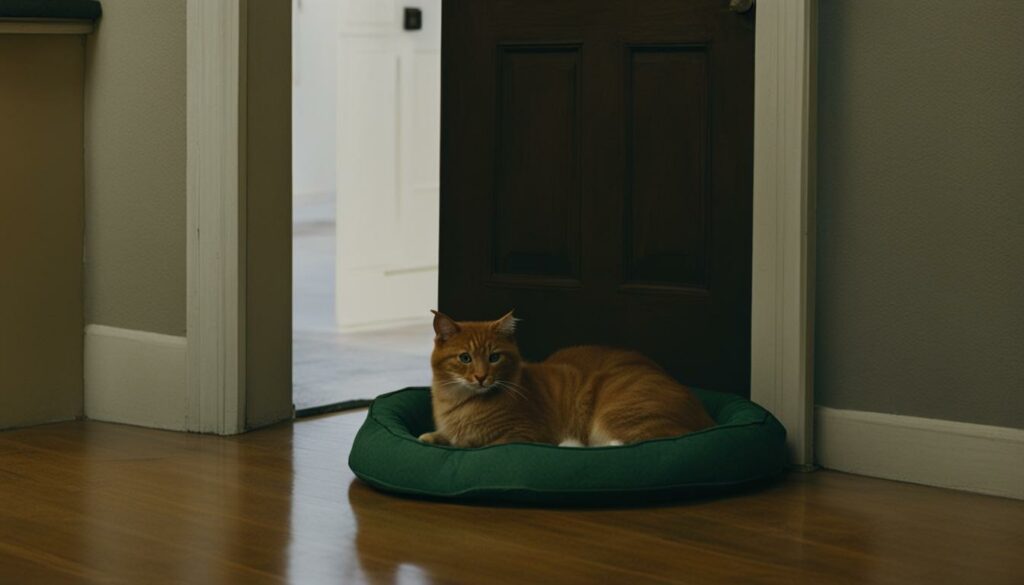Putting a cat down for urine blockage is a difficult decision that pet owners may face. Understanding the options available is important in making an informed choice. It is essential to consider the severity of the blockage, the potential for complications, and the overall quality of life for the cat.
Key Takeaways:
- Putting a cat down for urine blockage is a challenging decision that requires careful consideration.
- Understanding the severity of the blockage and possible complications is essential.
- Consider the overall quality of life for the cat before making a decision.
- Consult with a veterinarian to explore all available options.
- Early intervention and proper treatment can significantly improve the chances of recovery.
What Is a Urinary Tract Blockage in Cats?
A urinary tract blockage in cats, also known as a urethral obstruction, occurs when the urethra is blocked, preventing the cat from emptying its bladder. This condition is more common in male cats due to the narrowness of their urethra. If left untreated, a urinary tract blockage can lead to life-threatening complications, such as kidney failure and bladder rupture.
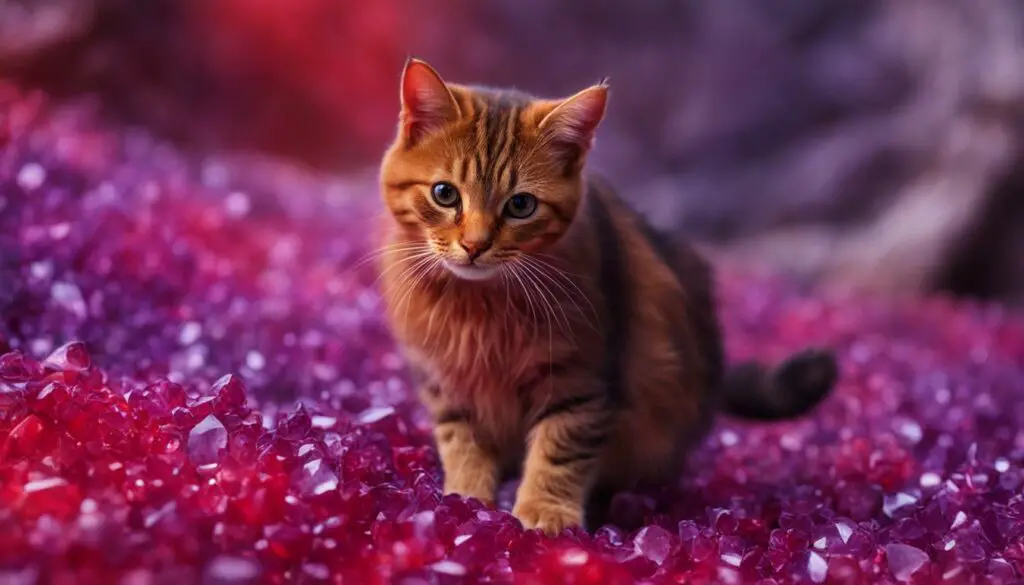
Urinary tract blockages can be caused by various factors, including the formation of urethral plugs, bladder stones, urethral strictures, and inflammation. These blockages can result in the buildup of urine in the bladder, leading to discomfort and potentially severe health issues.
It is important to recognize the symptoms of a urinary tract blockage, such as straining to urinate, bloody urine, and frequent trips to the litter box. If you suspect that your cat may be experiencing a urinary tract blockage, it is crucial to seek veterinary care immediately. Prompt treatment is essential to relieve the obstruction and prevent further complications.
Symptoms of Urinary Tract Blockage in Cats
A urinary tract blockage in cats can be a serious and potentially life-threatening condition. Recognizing the symptoms of a urinary tract blockage is crucial in order to seek immediate veterinary attention. The following are common symptoms that may indicate a urinary tract blockage:
- Bloody urine
- Increased frequency of urination
- Straining to urinate
- Urinating outside the litter box
- Licking the genital area excessively
- Vocalization or signs of pain while urinating
- Lethargy or decreased activity level
- Loss of appetite
- Vomiting and diarrhea
If your cat is displaying any of these symptoms, it is important to consult with a veterinarian to determine the underlying cause and appropriate treatment.
FLUTD and FIC
Sometimes, the symptoms of a urinary tract blockage can be confused with other urinary conditions, such as feline lower urinary tract disease (FLUTD) or feline idiopathic cystitis (FIC). FLUTD is a term used to describe a group of urinary disorders, including urinary tract infections, bladder inflammation, and the formation of crystals or stones. FIC, on the other hand, refers to bladder inflammation of unknown cause.
A definitive diagnosis is necessary to distinguish between a urinary tract blockage and these other conditions. Veterinary diagnostic tests, such as urinalysis, imaging studies, and physical examination, can help identify the underlying cause of the symptoms and guide appropriate treatment.
| Condition | Symptoms |
|---|---|
| Urinary Tract Blockage | Bloody urine, increased frequency of urination, straining to urinate, urinating outside the litter box, licking the genital area, vocalization, lethargy, decreased appetite, vomiting, and diarrhea. |
| FLUTD | Bloody urine, increased frequency of urination, urinating outside the litter box, painful urination, and signs of discomfort. |
| FIC | Bloody urine, frequent urination, straining to urinate, and signs of discomfort. |
It is important to consult with a veterinarian for an accurate diagnosis and appropriate treatment plan based on your cat’s specific condition.
Causes of Urinary Tract Blockage in Cats
There are several common causes of urinary tract blockage in cats. These include:
- Urethral plugs: Urethral plugs are a combination of crystals and mucus that can block the urethra, preventing the flow of urine. They are one of the most frequent causes of urinary tract blockage in cats.
- Bladder stones: Bladder stones can form in the bladder and may travel to the urethra, causing a blockage. These stones can be composed of different minerals, such as struvite or calcium oxalate.
- Urethral strictures: Urethral strictures are narrowings in the urethra that can result from scar tissue formation. These strictures can obstruct the flow of urine.
- Inflammation: Inflammation in the urinary tract can lead to the formation of a blockage. While the exact cause of inflammation is often unknown, it is believed to play a role in the development of urinary tract blockage.
It is essential to determine the underlying cause of urinary tract blockage in order to provide appropriate treatment and prevent future blockages. A veterinarian will perform diagnostic tests to identify the specific cause and tailor the treatment plan accordingly.
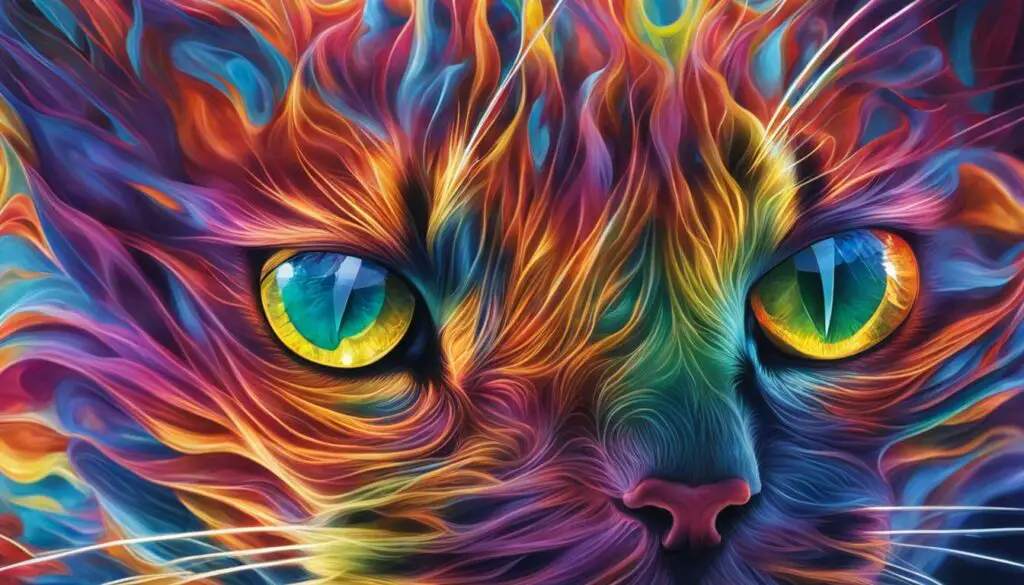
How Veterinarians Diagnose Urinary Tract Blockage in Cats
When it comes to diagnosing urinary tract blockage in cats, veterinarians employ a comprehensive approach that involves various techniques and procedures. By gathering a detailed medical history, conducting a thorough physical examination, and utilizing advanced diagnostic tools, veterinarians can accurately identify the presence and severity of urinary tract blockage.
During the physical examination, veterinarians will palpate the abdomen to locate the bladder and assess its size and shape. This can provide valuable information about the presence of a blockage and any associated complications. Additionally, veterinarians may perform tests such as ultrasounds and x-rays to visualize the urinary tract and identify any obstructions or abnormalities.
Furthermore, blood tests and urinalysis play a crucial role in diagnosing urinary tract blockage. Blood tests can reveal abnormalities in kidney function and electrolyte imbalances, while urinalysis helps assess the presence of blood, crystals, or infection in the urine. These diagnostic tests provide valuable insights into the underlying cause of the blockage and guide the treatment approach.
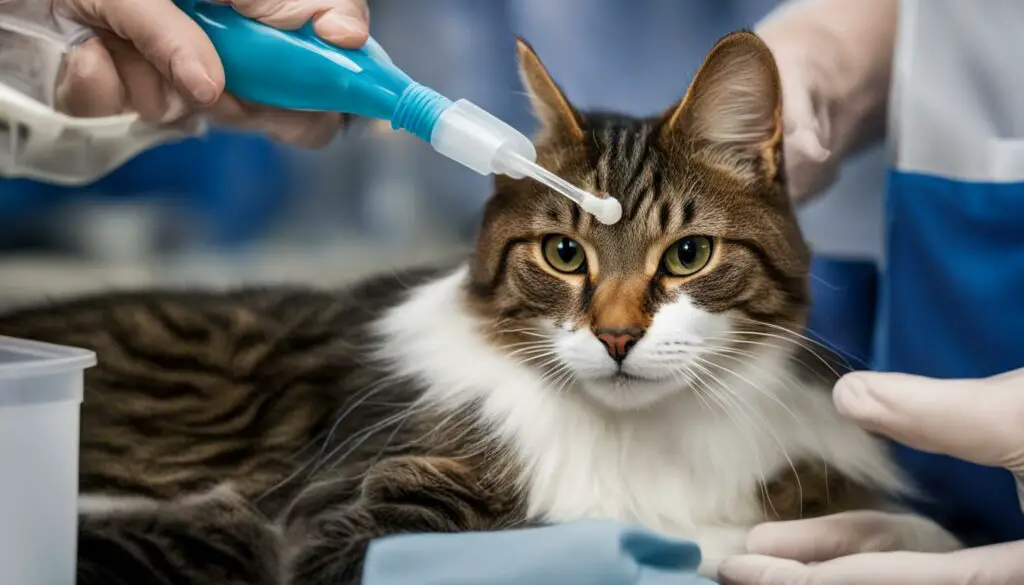
Key Methods for Diagnosing Urinary Tract Blockage:
- Medical history: Understanding the cat’s medical background, symptoms, and previous treatment.
- Physical examination: Palpation of the abdomen and assessment of the bladder’s size and shape.
- Ultrasound: Visualization of the urinary tract using sound waves to identify obstructions or abnormalities.
- X-ray: Radiographic imaging to provide detailed images of the urinary tract and detect blockages or stones.
- Blood tests: Analysis of blood samples to assess kidney function and identify any imbalances.
- Urinalysis: Examination of urine samples to detect the presence of blood, crystals, or infection.
By combining these diagnostic methods, veterinarians can accurately diagnose urinary tract blockage in cats and determine the most appropriate treatment plan. Early and accurate diagnosis is crucial in ensuring prompt intervention, thereby improving the cat’s chances of a successful recovery.
Treatment of Urinary Tract Blockage in Cats
When it comes to treating urinary tract blockage in cats, the main goal is to relieve the obstruction and manage any associated complications. This typically involves a combination of medical interventions and supportive care to ensure the cat’s well-being and promote a speedy recovery.
Relieving the obstruction: One of the primary methods of treating urinary tract blockage is by inserting a urinary catheter under sedation or anesthesia. This allows the urine to flow freely and helps alleviate the blockage.
Pain management and supportive care: Alongside relieving the obstruction, cats with urinary tract blockage may receive pain medication, intravenous (IV) fluids, and antibiotics to ensure their comfort and prevent infection. Additionally, a prescription diet may be prescribed to support recovery and prevent future blockages.
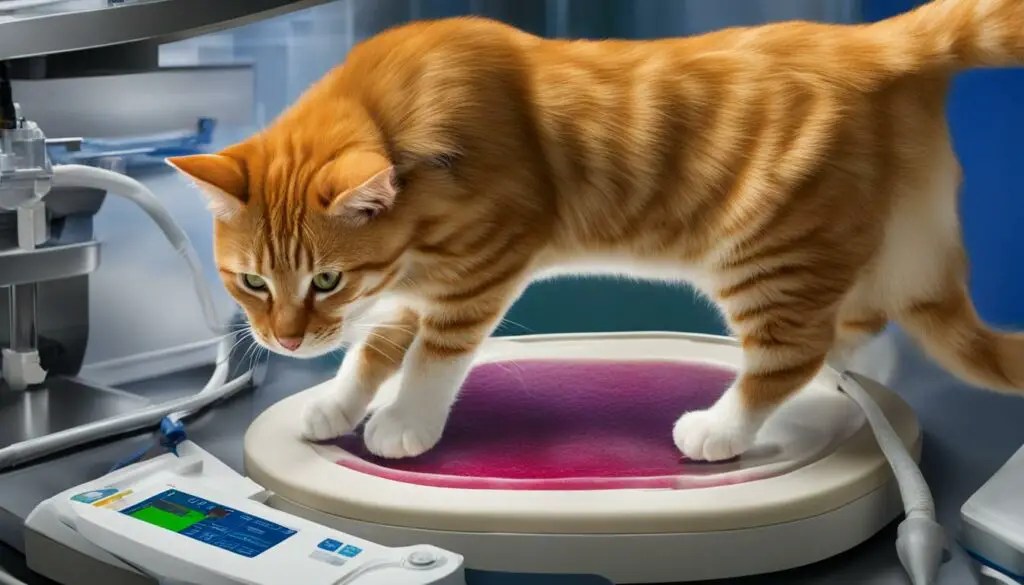
Table: Summary of Treatment Options for Urinary Tract Blockage in Cats
| Treatment | Description |
|---|---|
| Urinary catheter placement | Relieves the obstruction by allowing urine to flow freely |
| Pain medication | Provides relief from discomfort |
| IV fluids | Helps maintain hydration and support kidney function |
| Antibiotics | Prevents or treats any potential infections |
| Prescription diet | Promotes recovery and helps prevent future blockages |
With proper treatment and ongoing management, cats with urinary tract blockage can experience a full recovery and go on to lead happy, healthy lives. It is essential to closely follow the veterinarian’s recommendations, monitor the cat’s progress, and seek immediate veterinary attention if any concerning symptoms or complications arise.
Recovery and Management of Urinary Tract Blockage in Cats
After initial treatment, cats with urinary tract blockage may need to remain hospitalized for a few days for monitoring, intravenous fluids, and pain management. Once they show improvement, they can be discharged, but ongoing management is essential. This may include medication to relax the urethra, oral pain medication, antibiotics as needed, and a prescription diet to prevent future crystal formation and promote bladder health. Increasing water consumption through a waterfall waterer and feeding a canned diet may also be recommended.
Monitoring the cat’s progress is crucial to ensure the efficacy of the treatment plan. Regular check-ups with the veterinarian are recommended to assess the cat’s overall health, monitor the urinary system, and make any necessary adjustments to the management plan if needed. The veterinarian may perform blood tests or urinalysis to evaluate the cat’s kidney function, measure urine concentration, and monitor for any signs of infection or inflammation.
A prescription diet formulated for urinary health can play a significant role in managing and preventing urinary tract blockage in cats. These diets are specially designed to promote a healthy urinary pH and prevent the formation of crystals or stones. Additionally, they may contain ingredients that help reduce inflammation and support bladder health. It is important to strictly follow the feeding guidelines provided by the veterinarian and avoid introducing any other foods or treats that may interfere with the diet’s effectiveness.
| Treatment Factors | Management Strategies |
|---|---|
| Medication to relax the urethra | Administer as prescribed by the veterinarian |
| Oral pain medication | Follow the veterinarian’s instructions, administer as needed |
| Antibiotics | Administer as prescribed by the veterinarian, complete the full course |
| Prescription diet | Feed exclusively as instructed by the veterinarian, avoid introducing other foods or treats |
| Increasing water consumption | Provide a waterfall waterer, offer wet food, encourage regular drinking |
Recovery from urinary tract blockage requires ongoing commitment and attention to the cat’s health. It is essential to create a stress-free environment, maintain a clean litter box, and provide ample opportunities for exercise and mental stimulation. Regular veterinary check-ups and open communication with the veterinarian are crucial for long-term management and prevention of future blockages.

Find Food That Fits Your Pet’s Needs
Choosing the right food for your pet is crucial, especially when it comes to maintaining urinary health. There are specific dog and cat foods available that are formulated to support urinary health and prevent blockages. These foods are designed to promote a healthy urinary pH and may help dissolve crystals or prevent their formation. It is important to consult with a veterinarian to find the best food option for your pet’s specific needs.
When selecting a pet food for urinary health, look for ingredients that promote a balanced urinary system. These may include ingredients like cranberries and blueberries, which are known for their urinary health benefits. Additionally, the food should be low in magnesium and phosphorus, as these minerals can contribute to the formation of urinary crystals and stones.
Some pet foods also contain added supplements, such as omega-3 fatty acids, which can help reduce inflammation in the urinary tract. These supplements can support overall urinary health and reduce the risk of blockages. It is important to read the labels and choose a pet food that meets your pet’s specific needs.
Causes of Male Cat Urinary Blockage
Male cats are more prone to urinary blockage due to their narrower urethra, which makes them more susceptible to blockages from urinary stones and urethral plugs. The narrow urethra provides less room for these obstructions to pass through, leading to potential blockages that can prevent the normal flow of urine. Additionally, male cats are more likely to develop feline idiopathic cystitis (FIC), an inflammatory condition of the bladder that can cause swelling and narrowing of the urethra, further increasing the risk of urinary blockages.
Types of Urinary Blockage Causes in Male Cats
Multiple factors can contribute to the formation of urinary blockages in male cats. The most common causes include:
- Urinary Stones: These are mineral deposits that can form in the urinary tract, including the bladder, urethra, and kidneys. When these stones become lodged in the narrow urethra of a male cat, they can block the passage of urine.
- Urethral Plugs: Urethral plugs are a combination of crystals, mucus, and cellular debris that can accumulate in the urinary tract. They can obstruct the flow of urine and lead to urinary blockages.
- Feline Idiopathic Cystitis (FIC): FIC is a condition characterized by inflammation of the bladder, often triggered by stress. This inflammation can cause swelling and narrowing of the urethra, making it more prone to blockages.
Addressing these underlying causes is crucial in preventing future urinary blockages in male cats. By understanding the risk factors and taking appropriate preventive measures, such as providing a stress-free environment, promoting hydration, and feeding a balanced diet, pet owners can help reduce the likelihood of urinary blockages in their male cats.
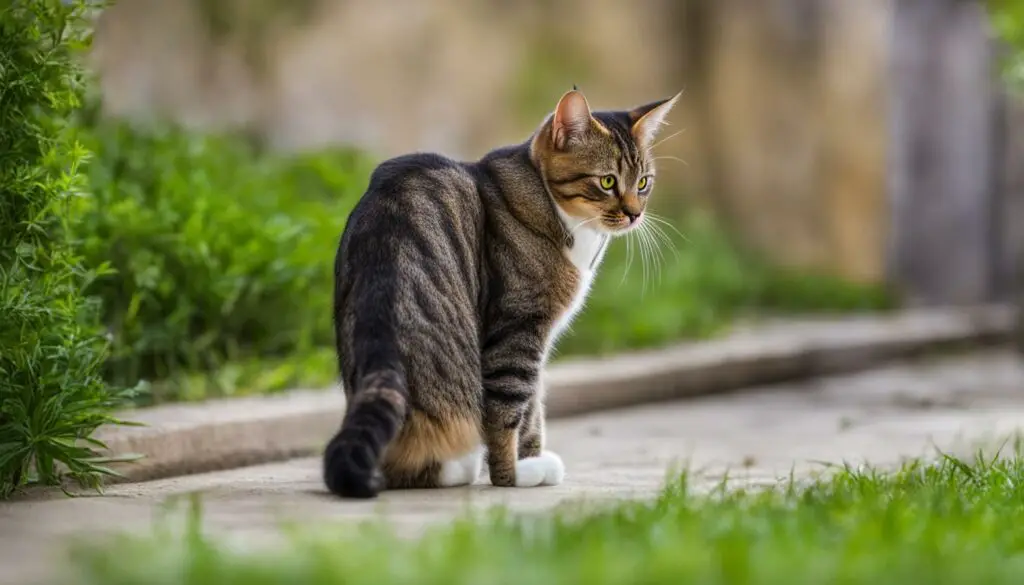
Signs and Diagnosis of Male Cat Urinary Blockage
Recognizing the signs of male cat urinary blockage is crucial for prompt diagnosis and treatment. If you notice your cat straining to urinate, producing bloody urine, or displaying signs of discomfort, it is important to seek veterinary attention immediately. These symptoms are indicative of a possible urinary blockage and should not be ignored.
Diagnosing a urinary blockage in male cats involves a combination of physical examination, palpation of the bladder, and additional tests. A veterinarian will likely perform a thorough physical examination to assess the cat’s overall condition and palpate the abdomen to feel for an enlarged or distended bladder. This can help determine the presence and severity of a blockage.
To confirm the diagnosis and identify the location of the blockage, further tests such as urinalysis and imaging may be necessary. Urinalysis can provide valuable information about the presence of crystals or blood in the urine, helping to pinpoint the cause of the blockage. Imaging techniques like X-rays or ultrasounds can provide a visual representation of the urinary tract and aid in determining the appropriate treatment approach.
| Signs of Male Cat Urinary Blockage | Blockage Diagnosis |
|---|---|
| Straining to urinate | Physical examination |
| Bloody urine | Palpation of the bladder |
| Discomfort | Urinalysis |
| Imaging (X-rays, ultrasounds) |
Early diagnosis and intervention are crucial in effectively managing urinary blockage in male cats. If you notice any of these signs, it is essential to consult with a veterinarian promptly to ensure appropriate treatment and prevent further complications.
Treating Urinary Blockage in Male Cats
When it comes to treating urinary blockage in male cats, there are several approaches that veterinarians may take. The primary goal is to unblock the urethra and provide relief to the cat. One common method is catheterization, which involves inserting a urinary catheter into the urethra under sedation or anesthesia. This allows for the free flow of urine and helps to resolve the blockage.
In addition to catheterization, medication may be prescribed to support the cat’s recovery. This can include pain medication to alleviate discomfort and antibiotics to prevent or treat any infections that may have developed. Other medications may also be used to relax the urethra, making it easier for the cat to urinate.
In more severe cases or when other treatment methods have been unsuccessful, surgery may be required. Perineal urethrostomy is a surgical procedure that involves creating a new opening in the urethra to bypass the site of the blockage. This can help to prevent future blockages from occurring, but it is a more invasive option that should be carefully considered.
| Treatment Options | Description |
|---|---|
| Catheterization | Insertion of a urinary catheter to unblock the urethra and allow the free flow of urine. |
| Medication | Pain medication, antibiotics, and other medications may be prescribed to support the cat’s recovery and prevent complications. |
| Surgery | In severe cases or when other treatments fail, surgery, such as perineal urethrostomy, may be necessary to prevent future blockages. |
It is important to consult with a veterinarian to determine the most appropriate treatment option for your cat. They will consider factors such as the severity of the blockage, the cat’s overall health, and any underlying conditions that may be contributing to the blockage. By working closely with your veterinarian, you can ensure that your cat receives the best possible care.
Remember, prompt treatment is crucial for the successful management of urinary blockage in male cats. If you notice any signs of a blockage, such as straining to urinate or blood in the urine, it is important to seek veterinary attention immediately. The sooner the blockage is addressed, the better the chances of a positive outcome for your feline friend.
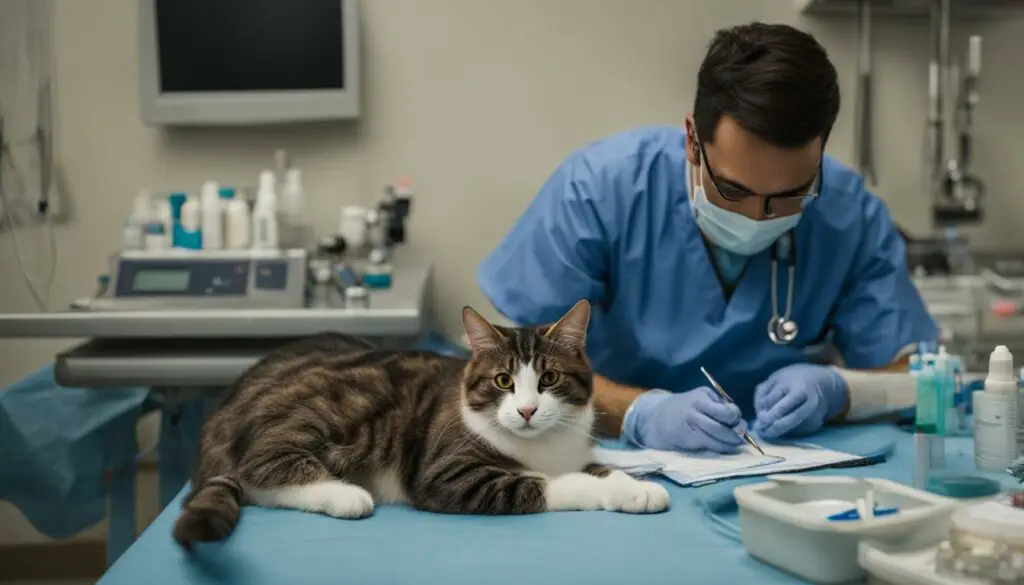
Please note: The image above is for illustrative purposes only and does not represent an actual case of urinary blockage in a male cat.
Preventing Male Cat Urinary Blockage
Preventing male cat urinary blockage is essential for the overall health and well-being of your feline companion. By implementing a few key strategies, you can reduce the risk of blockages and ensure a happy and healthy urinary tract for your cat.
Water consumption: Encouraging proper hydration is crucial in preventing urinary blockages. Provide fresh water sources throughout your home and consider using a cat fountain or waterfall waterer to entice your cat to drink more.
Diet: Feeding a diet that supports urinary health can significantly reduce the risk of blockages. Consult with your veterinarian to select a high-quality cat food that is specifically formulated to promote urinary tract health and prevent crystal formation.
Stress reduction: Stress can be a contributing factor to urinary blockages in cats. Create a calm and stress-free environment for your cat by providing plenty of hiding spots, vertical spaces, and interactive toys. Keeping a consistent routine and maintaining a clean litter box can also help reduce stress levels.
| Prevention Strategies for Male Cat Urinary Blockage | Key Points |
|---|---|
| Water consumption | Provide fresh water sources and consider using a cat fountain or waterfall waterer to encourage proper hydration. |
| Diet | Consult with your veterinarian to select a high-quality cat food that supports urinary health and prevents crystal formation. |
| Stress reduction | Create a calm and stress-free environment by providing hiding spots, vertical spaces, and interactive toys. Maintain a consistent routine and clean litter box. |
“By implementing these prevention strategies, you can significantly reduce the risk of urinary blockage in male cats. Proper hydration, a balanced diet, and stress reduction are key factors in maintaining a healthy urinary tract. Remember to consult with your veterinarian for personalized advice and recommendations.”
Conclusion
Preventing male cat urinary blockage requires proactive measures to promote urinary health and reduce the risk of blockages. By focusing on water consumption, diet, and stress reduction, you can help keep your cat’s urinary tract functioning properly. Remember to consult with your veterinarian for guidance and recommendations tailored to your cat’s specific needs.
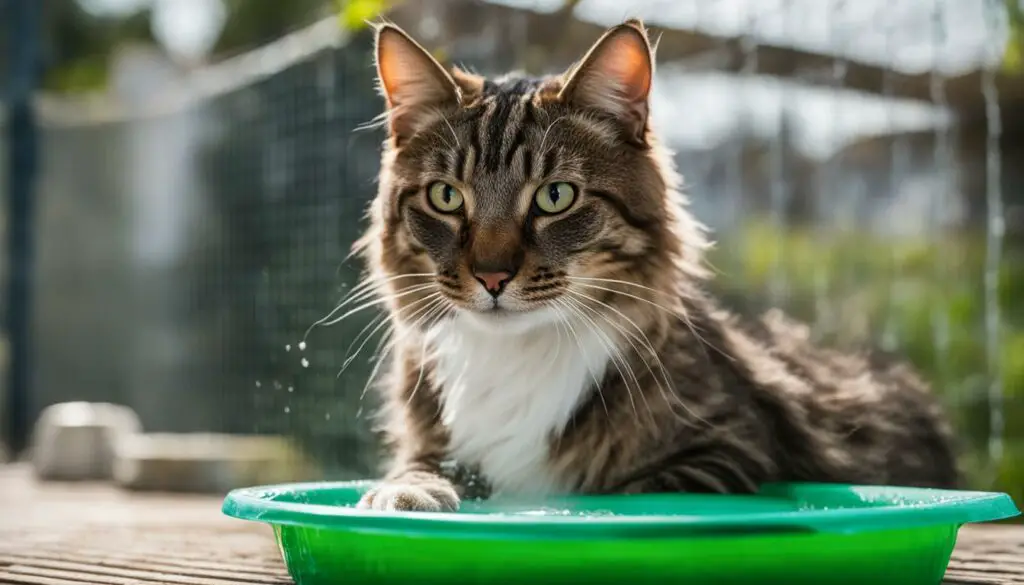
The Role of Stress in Urinary Tract Blockage
Stress plays a significant role in the development and exacerbation of urinary tract blockage in cats. Feline Lower Urinary Tract Disease (FLUTD), which encompasses various urinary conditions, including blockages, can be triggered or worsened by stress. Cats are highly sensitive animals, and changes in their environment, interactions with other pets, or even competition for resources can lead to increased stress levels.
Reducing stress is an essential aspect of preventing urinary tract blockages in cats. Creating a calm and consistent routine can help provide a sense of security and predictability for your feline companion. Ensuring an enriched environment with plenty of hiding spots, scratching posts, and toys can also help alleviate stress by providing outlets for natural behaviors and mental stimulation.
Additionally, addressing any potential sources of conflict among multiple pets in your household can help reduce stress. Providing separate feeding areas and litter boxes for each cat, as well as ensuring that each cat has access to resources without competition, can help minimize stress levels and promote a harmonious living environment.
| Stress-Reducing Strategies for Cats | Benefits |
|---|---|
| Environmental Enrichment | Provides mental stimulation and outlets for natural behaviors |
| Consistent Routine | Reduces anxiety by providing predictability |
| Separate Resources | Minimizes competition and potential conflict among cats |
| Regular Playtime | Allows cats to release energy and reduce stress |
Incorporating stress-reducing strategies into your cat’s daily routine can help promote overall well-being and reduce the risk of urinary tract blockage. However, it is important to consult with your veterinarian to develop a comprehensive plan that addresses your cat’s specific needs and circumstances.

The Challenges of Treating Urinary Tract Blockage in Cats
Treating urinary tract blockage in cats presents several challenges due to the medical complexity of the condition and the financial burden it can impose on pet owners. This article will explore these challenges in detail, providing insight into the complexities of managing this condition and the potential impact on pet owners.
Medical Complexity
Table: Challenges of Treating Urinary Tract Blockage
| Challenge | Description |
|---|---|
| Recurrent Blockages | Urinary tract blockage in cats can be a recurring problem, requiring multiple treatments and interventions to prevent future blockages. This can be emotionally and financially draining for pet owners. |
| Underlying Causes | Identifying the underlying causes of urinary tract blockage can be challenging. It may involve extensive diagnostic procedures and require ongoing management of underlying conditions, such as feline idiopathic cystitis. |
| Emergency Situations | Urinary tract blockage can quickly become a life-threatening emergency. Immediate intervention is necessary to relieve the obstruction and prevent severe complications, making it a high-stress situation for both pet owners and veterinary professionals. |
“Treating urinary tract blockage in cats can be a complex process that requires careful monitoring, ongoing management, and a comprehensive understanding of the underlying causes.”
Financial Burden
Treating urinary tract blockage in cats can also pose a significant financial burden on pet owners. The costs associated with diagnostic tests, hospitalization, medications, and ongoing management can add up quickly. Pet insurance can help alleviate some of the financial strain, but it is essential for pet owners to be prepared for the potential costs involved in managing this condition.
Additionally, some cats with recurring blockages may require more advanced treatments like perineal urethrostomy surgery, which can be costly. Pet owners should discuss all treatment options, their associated costs, and the probability of recurrence with their veterinarian to make informed decisions about their pet’s care.
In conclusion, treating urinary tract blockage in cats is a challenging endeavor that requires a comprehensive approach, including diagnostic tests, medical interventions, and ongoing management. Pet owners should be prepared for the medical complexity of the condition and the potential financial burden it may entail. By understanding these challenges, pet owners can make informed decisions about their cat’s treatment and provide the best possible care.
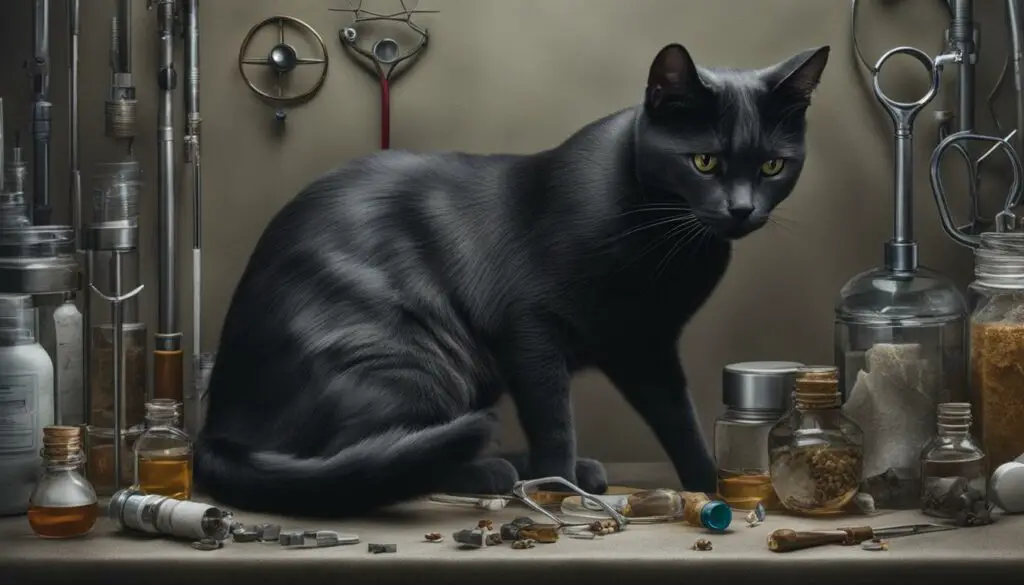
Conclusion
Putting a cat down for urine blockage is an incredibly difficult decision that no pet owner wants to face. However, understanding the available options is crucial in ensuring the best outcome for our furry friends. It’s important to consider the severity of the blockage, potential complications, and the overall quality of life for the cat.
Early intervention plays a vital role in increasing the chances of a successful recovery. Timely diagnosis and appropriate treatment can save a cat’s life and prevent further complications. If you notice any symptoms of urinary tract blockage, such as straining to urinate or bloody urine, it’s crucial to seek veterinary care immediately.
When it comes to treating urinary tract blockage, there are various options available, including relieving the obstruction through the use of a urinary catheter, administering pain medication, and providing IV fluids. Ongoing management and prevention strategies, such as prescription diets and increasing water consumption, can help reduce the risk of future blockages.
Remember, your feline companion depends on you to make informed decisions about their health. By understanding the causes, symptoms, and treatment options for urinary tract blockage, you can provide the best possible care and support for your beloved cat.
FAQ
What are the symptoms of urinary tract blockage in cats?
Symptoms of urinary tract blockage in cats may include bloody urine, increased frequency of urination, straining to urinate, urinating outside the litter box, licking the genital area, vocalization, lethargy, decreased appetite, vomiting, and diarrhea.
What causes urinary tract blockage in cats?
Common causes of urinary tract blockage in cats include urethral plugs, bladder stones, urethral strictures, and inflammation.
How do veterinarians diagnose urinary tract blockage in cats?
Veterinarians diagnose urinary tract blockage in cats by taking a complete medical history, performing a thorough physical examination, and conducting additional tests such as ultrasounds, x-rays, blood tests, and urinalysis.
How is urinary tract blockage in cats treated?
Treatment for urinary tract blockage in cats typically involves placing a urinary catheter, providing pain medication, intravenous fluids, antibiotics, and a prescription diet to support recovery and prevent future blockages.
How can I prevent urinary blockage in my male cat?
Preventing male cat urinary blockage involves increasing water consumption, feeding a diet that supports urinary health, and reducing stress through environmental enrichment and maintaining a calm routine.
How does stress contribute to urinary tract blockage in cats?
Stress can contribute to feline lower urinary tract disease (FLUTD) and increase the risk of urinary tract blockage in cats. Reducing stress through environmental enrichment and maintaining litter box hygiene can help prevent blockages.
What are the challenges of treating urinary tract blockage in cats?
Treating urinary tract blockage in cats can be challenging due to the complex nature of the disease and the potential for recurrence. Cats may require multiple hospitalizations, medical interventions, and ongoing management.

